Future of eCommerce: 10 Trends You Need to Know
What is the future of eCommerce? If you have ever pondered over this question, then you have come looking at the right place. This article goes through all the hot topics and eCommerce trends that current and future eCommerce business owners must know. Whether it be the eCommerce technology that takes center stage in the future or a key user behavior trait, you will find it all here.
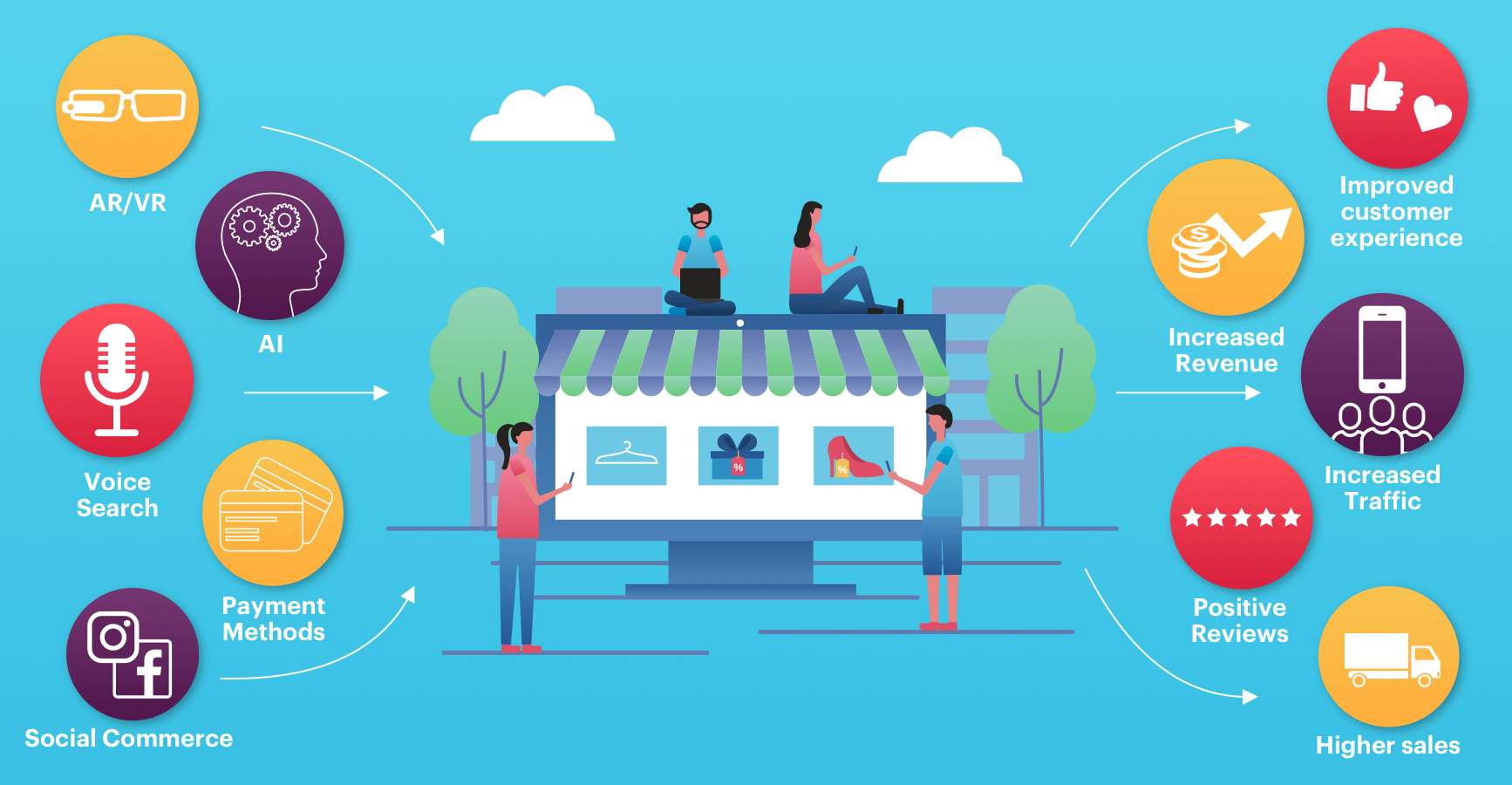
Capitalizing on the right eCommerce trend can catapult your business to great heights. The learnings give one a great deal of insight into the right ways of eCommerce platform development. Amazon is one excellent example of winner-takes-all, in this ecosystem. It might be a slight exaggeration but you can’t deny Amazon’s dominance in the eCommerce ecosystem. The situation demands you to keep a note of the latest trends and stay proactive.
The global eCommerce market is estimated to reach a whopping $5879.1 billion by 2022. That’s a serious number but getting even a small chunk of this pie needs you to be on top of your game. You need to be in tune with all the technological advancements along with consumer demands.
Identifying the right eCommerce trend is, therefore, the next big challenge you face. This article goes through 10 eCommerce trends that are shaping the future of this industry as we speak.
It covers technologies that attract more shoppers, frameworks that help build better eCommerce ecosystems and attract more shoppers. I’ve also put together new strategies that eCommerce giants follow for more efficient marketing. So let’s dive right into the list:
- AR and VR’s immersive user experience increases product value
- Smarter decisions from AI help boost sales
- More payment methods reduce cart abandonment
- Attract more customers with the hands-free voice search option
- Ace customer interactions with smarter Chatbots
- Make your online store more accessible with Mobile Commerce
- Headless eCommerce makes the system more nimble and agile
- Ecommerce platforms and frameworks for varying needs
- Better UI/UX leads to more customer retention
- Social commerce is critical to an omnichannel experience
AR and VR’s immersive user experience increases product value
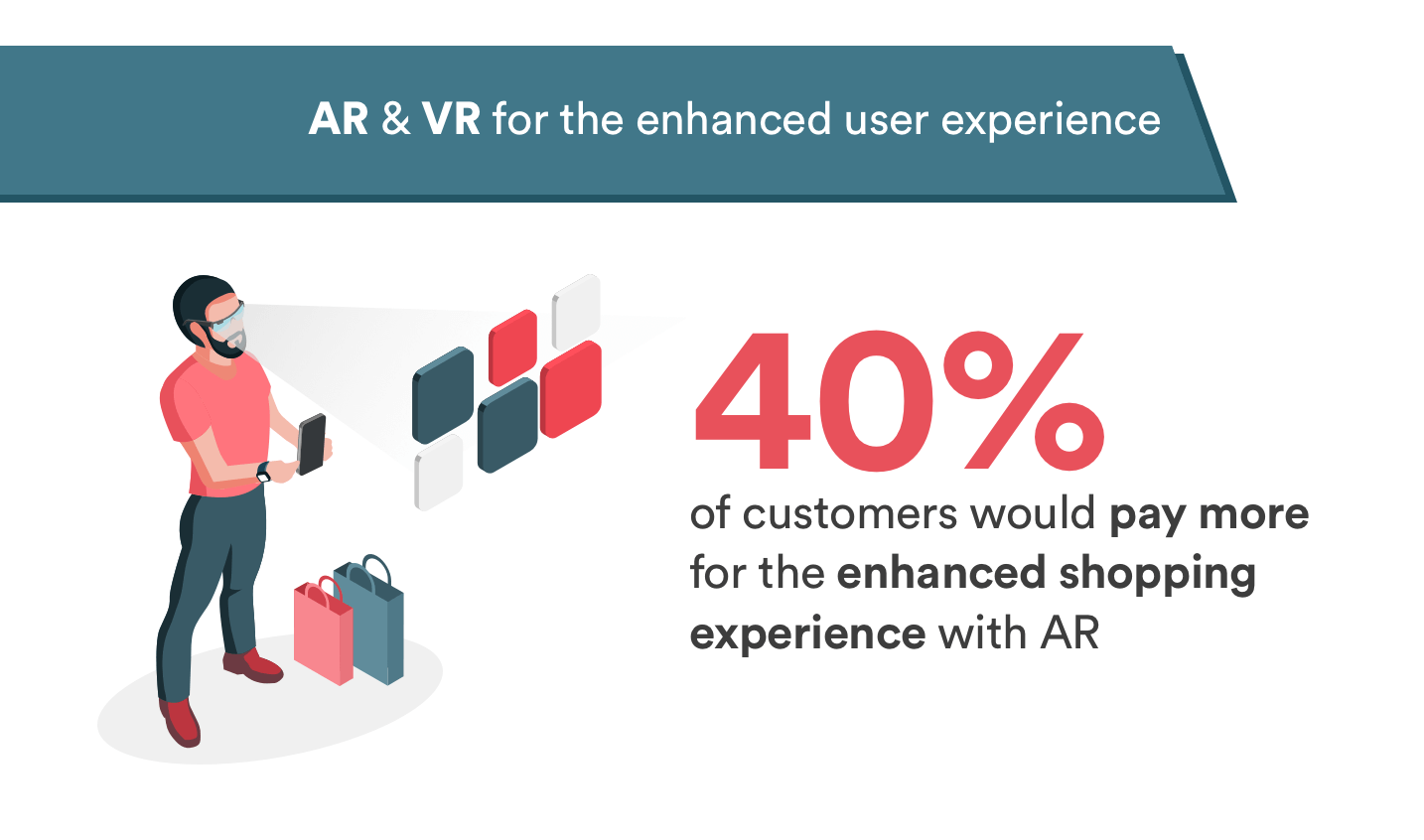
Do more than images and videos to get ahead of competitors: It hasn’t been long since videos got mainstream on eCommerce websites, and the trend has already started getting obsolete. AR and VR tower over most customer experience enhancing strategies. Perhaps the only way to beat these two technologies is to put the shopper in a real physical store.
Allow customers to try before they buy: Consumers feel betrayed when their orders don’t turn out to be as they expected. It could either be a misfit, a difference in shade, or a poor build-quality, etc.
AR promotes the try-before-you-buy approach, setting realistic customer expectations. This, in turn, improves a brand’s image and boosts its sales. 100 million customers are expected to use AR this year, and the time is ripe for eCommerce businesses to hop on this bandwagon.
Deliver a more immersive user experience: AR not only helps alleviate the issues mentioned but it also boosts sales because of the immersive experience. By integrating AR with your app, shoppers stay 2.7 times longer and are 11 times more likely to make a purchase. Still not convinced? Keep reading!
The future of retail is powered by machine learning, natural language processing, computer vision, smart robotics), extended reality (AR/VR), IoT, 3D print, chatbots, digital commerce and voice mobile assistants. #NRF2020 pic.twitter.com/mUyCJ2n7nJ — Vala Afshar (@ValaAfshar) January 12, 2020
Improve brand popularity: Ikea launched IKEA Place, an AR app on the App Store, to make the buying decision a lot easier for customers. It didn’t take long for the app to grab the second position on the chart for free apps on Apple’s ARKit. What makes this feat more remarkable is the fact that IKEA Place left a lot of AR gaming apps behind to grab the spot. The immersive experience led to positive customer reviews on the app. The benefits make it difficult for anyone to ignore this retail eCommerce trend.
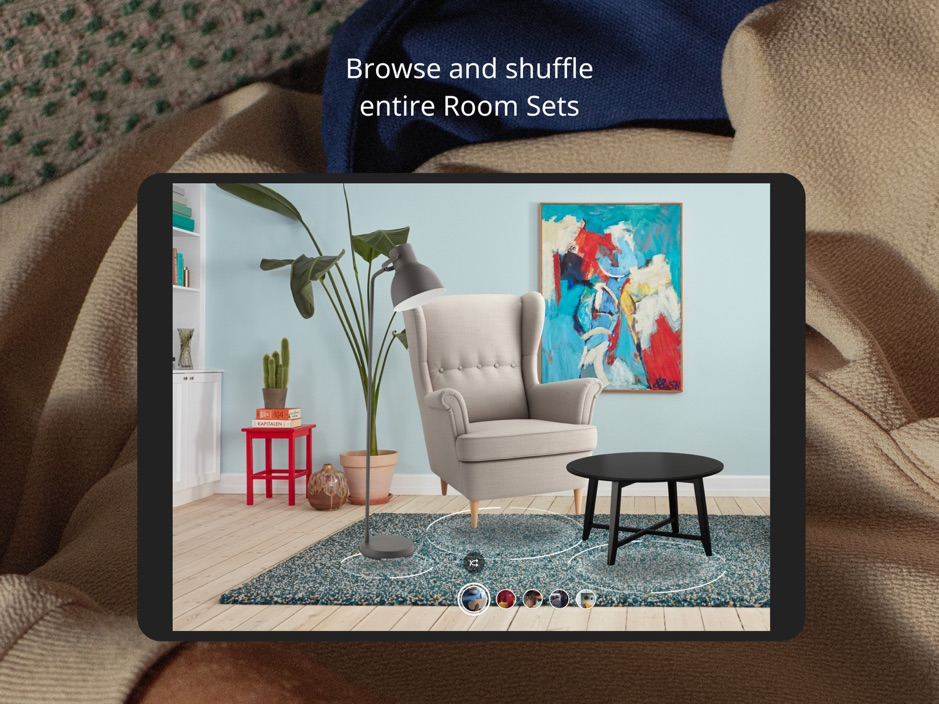
Increases product value: And it’s not just furniture sellers like IKEA that benefit from AR. Sephora, a seller of cosmetics and beauty products, allows its customers to try the beauty products virtually. In fact, a survey pointed out that 40% of the consumers are even willing to pay more if AR is a part of their shopping experience. Ergo, the possibilities are endless with AR.
More brands and customers are getting into VR: While AR is turning out to be a boon for eCommerce businesses, VR isn’t far behind. Google has already shipped around 15 million cardboard headsets, and you bet people would want to use them for online shopping.
The two eCommerce giants – Amazon and Alibaba – made some efforts to bring online stores to life using VR. Both of them attempted to create virtual stores for shoppers and still continue investing in the technology. The future of eCommerce seems to head the AR/VR way, and you can’t take eyes off this eCommerce technology trend.
Smarter decisions from AI help boost sales
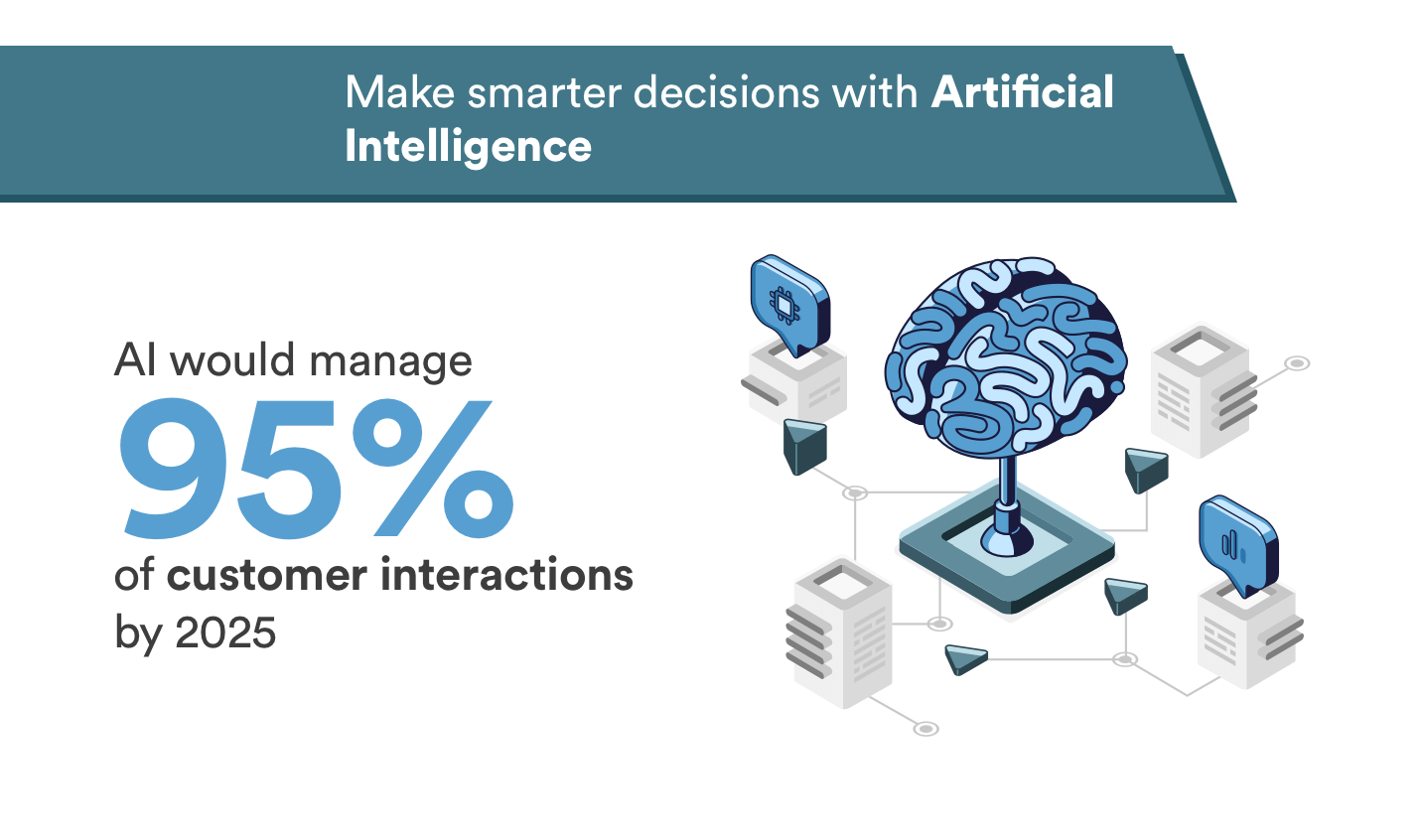
AI needs no advocate to signify its importance to the future of eCommerce. A lot of these eCommerce trends mentioned have a connection to AI. Be it voice search, chatbots, or even social commerce, AI enhances them all.
Improves efficiency and reduces costs: Big Data and Machine Learning (ML) are partners in crime to AI. The trio has helped countless businesses automate tasks which would’ve otherwise been impossible to do manually. How do you think Amazon manages to change product prices by 2.5 million times a day? It would have been humanly impossible for them to go through such a vast data pool, and then come up with modified pricing of products wherever necessary.
Create smarter strategies with predictive analytics: Predictive analytics is just one of the ways how AI can turn out to be a fruitful technology for eCommerce. Some of its other branches are behavioral analytics, automation, inventory management, and image recognition. It is because of a wide range of applications using it that the AI revenue is expected to reach $36.8 billion worldwide by 2025.
Personalization to improve customer experience and customer loyalty: eCommerce Strategist, Ed Kennedy, says, “The main way it’s (AI) used is personalization. Personalizing the experience that a consumer sees when they come shopping on your website is powered by machine learning and AI in many many eCommerce sites.”
Suits all sizes of businesses: eCommerce businesses, big and small, benefit greatly from the use of AI. The North Face is one of the leading outdoor recreation product retailers which makes for a great example of an organization that improved their customer experience with AI.
Their platform is powered by IBMs Watson that helps visitors find the right product from their vast catalog. It asks shoppers the right questions and then provides relevant results. Another example is Netflix: it is said they avoided a $1 billion annual loss because of AI.
Of all the old and new eCommerce technologies, AI is perhaps the most important among the trends of eCommerce.
More payment methods reduce cart abandonment
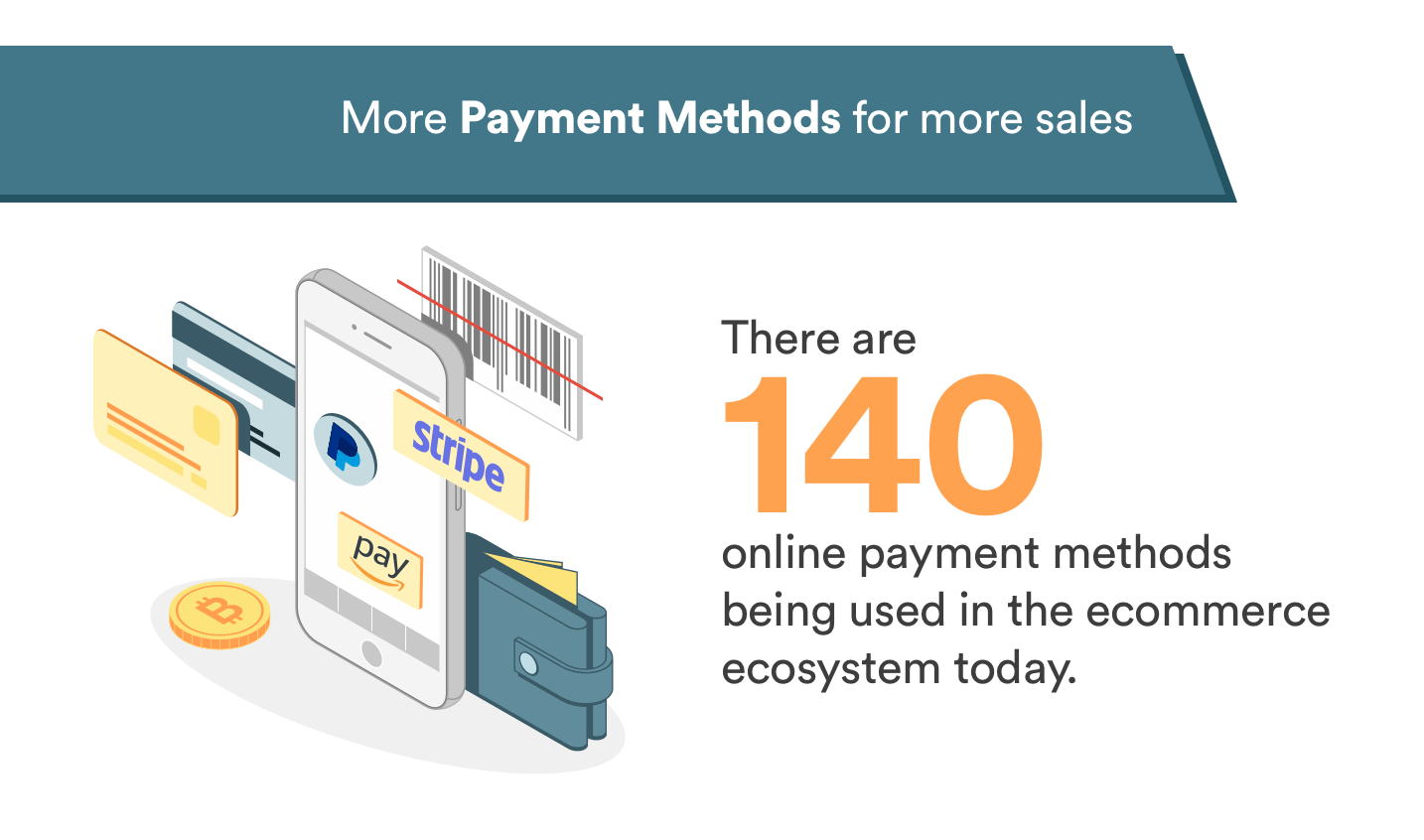
Reduce cart abandonment with more payment methods: Credit cards were synonymous with online payment for a long time However, the emergence of payment modes like e-Wallets, bank transfers, prepaid cards, cash on delivery, and others alike compelled e-Commerce platforms to integrate these methods with their platform. And as if this wasn’t enough, cryptocurrency was quick to gain popularity among internet dwellers.
With over 50% shoppers exiting an app if they don’t find their preferred payment method, it is a safe bet to add more payment modes to shrink your cart abandonment rate.
More payment methods lead to improved customer experience: If an eCommerce business wants to reach the top of the food chain, then it can’t ignore any of the available payment technologies. It can quickly turn out to be a mammoth of a task to handle since there are 140 online payment methods available on eCommerce platforms. The more payment options you provide, the easier it is for the customer to buy the product.
#Ecommerce businesses, listen up. You may already be accepting Paypal, Apple Pay, Google Pay. But, did you know more payment methods are rising to meet the needs of online customers? 💸 pic.twitter.com/Ee8sj6xSmP — Utrust (@UTRUST) September 2, 2019
Pick the right APMs to reduce legwork and increase sales: You need to identify the right Alternative Payment Models (APM) based on the target audience and other relevant factors. You also can’t keep security out of this debate, but thankfully most APMs come with enough security measures.
Modern payment mechanisms are getting increasingly popular among shoppers. So much so that you can expect these payment methodologies to remain in future eCommerce trends for a long time.
Attract more customers with the hands-free voice search option
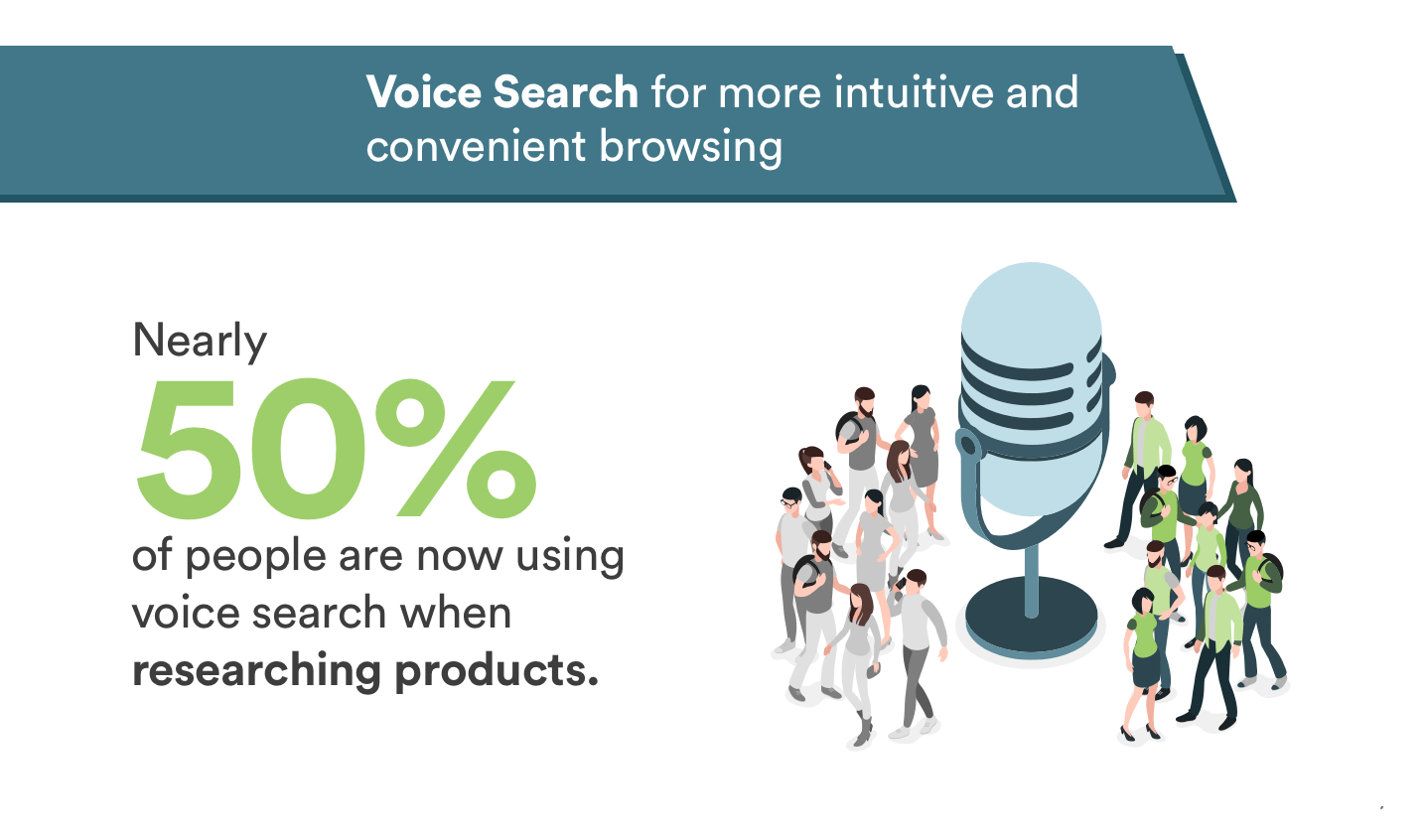
Get more customers with the hands-free experience: Nothing beats the convenience of interacting with a device as if you were interacting with another human being. Google Assistant, Alexa, Siri, and Cortana are getting more mainstream as we speak.
In fact, 50% online users prefer using voice assistants to buy products; what’s more, another 25% users are likely to use this technology in the future. These statistics make a good reason for you to leverage voice search to make it easier for customers to find you and your products.
Becoming voice friendly now will give you more sales in the future: It is expected that 30% of internet browsing sessions are going to happen without a screen this year. Retails and eCommerce businesses need to be voice-search ready, and it is non-negotiable. People have already started making purchases using voice search. 26% of consumers having smart speakers have already bought something using the device, and eCommerce trends suggest this share to only increase in the future.
Natural Language Processing (NLP) will help you sell more products: A lot goes into an eCommerce business becoming voice-friendly. They need to work on NLP, using ML and AI for appropriate responses and ensuring user privacy. With these measures in place, it will be easier for users to find your products. Consequently, you get to sell more products.
Leverage existing voice search tools to grow your business: Domino’s was proactive in capitalizing on this hands-free technology. They allowed people to dictate orders to their devices, making it simpler and more convenient to order pizza. They leveraged the existing voice assistant ecosystem to boost business– a move all eCommerce websites should take note of.
With voice shopping expected to reach $40 billion by 2022, you can’t keep this eCommerce trend out of the picture while planning a roadmap for the future.
Ace customer interactions with smarter Chatbots
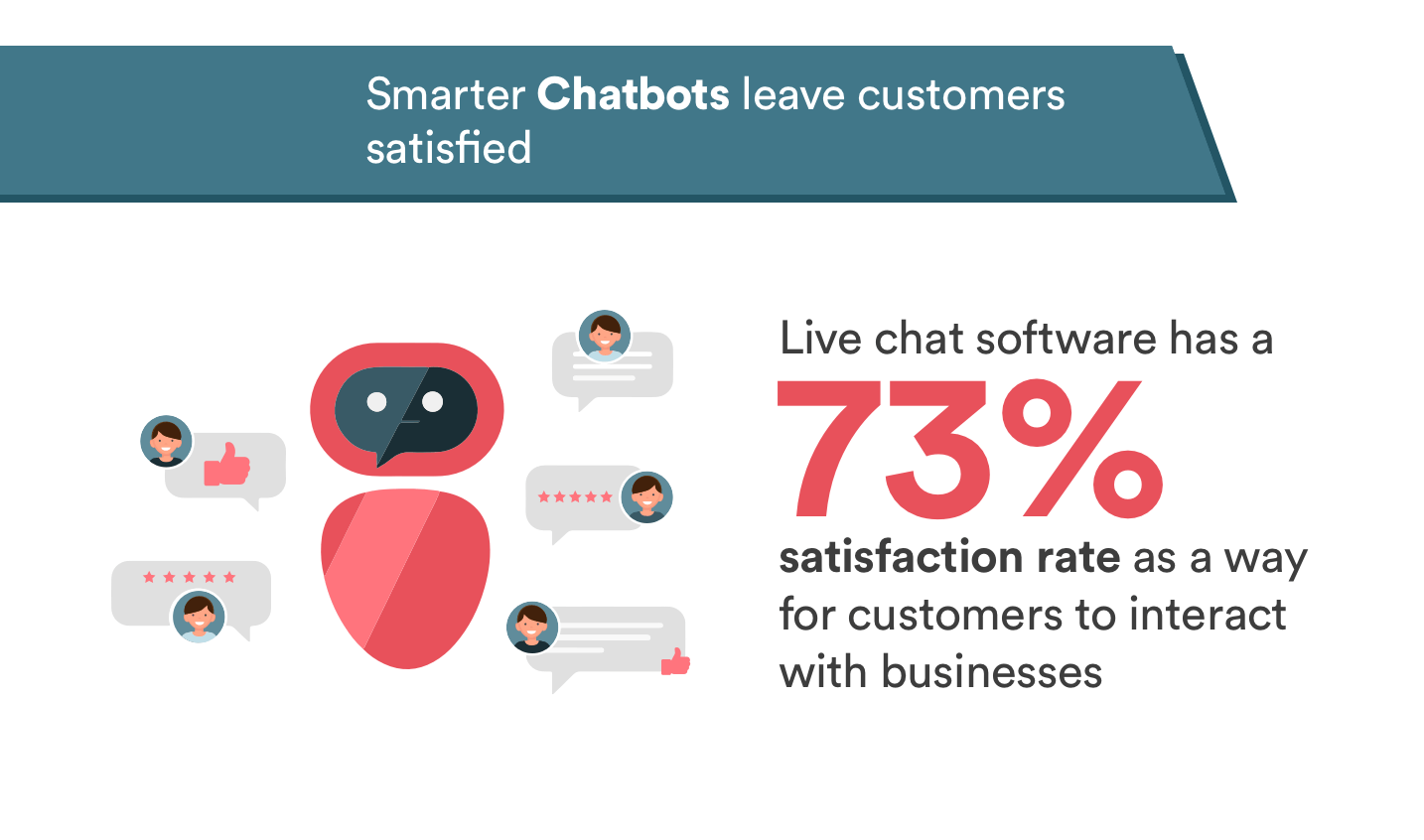
As we move from voice search to chatbots, the crux remains the same. Shoppers want to have more humane and intelligent interactions with shopping platforms. Chatbots have been a part of eCommerce systems for a long time now, but it’s fairly recent that they got smarter.
Save costs by employing more chatbots: 85% of customer interactions with businesses are happening without humans. It means you need to tap into the full potential of chatbots. They can take care of a wide range of services right from customer service to generating leads for the business.
Chatbots and voice search mechanisms face similar challenges in the form of NLP and AI, but chatbots are less revolutionary than the latter. You don’t need to care much about voice recognition, for people are more specific when they write.
Conversational chatbots improve brand image: There are 1.4 billion people using chatbots around the world. Messaging apps have already got them used to this form of interaction, making things much easier for you. Shoppers aren’t a great fan of canned messages and poor scripts. It’s recommended to steer clear from these tactics. You can’t get away with providing them just any automated responder.
For an online #business, it has become very difficult to stand out and differentiate. https://t.co/UjBFGWFkT0 Ecommerce #chatbots are a new way of providing amazing shopping experiences. pic.twitter.com/IKJOsBG9BU — Tech Business Guide (@TechBusinessG) March 8, 2020
The need of the hour is for eCommerce and retail platforms to have conversational chatbots. These can be deployed on the platform as well as on various social apps.
Boost sales with interactive chatbots: Nike’s chatbot is a great example. It not only nurtures better customer relations but also boosts sales. The chatbot has a fun and cheerful personality, something that most sneakerheads would appreciate. It helps them find the right sneakers by processing the images they upload and taking user preferences into account.
The future of eCommerce businesses very much depends on customer interactions, making conversational chatbots the right step in the direction.
Make your online store more accessible with mobile commerce
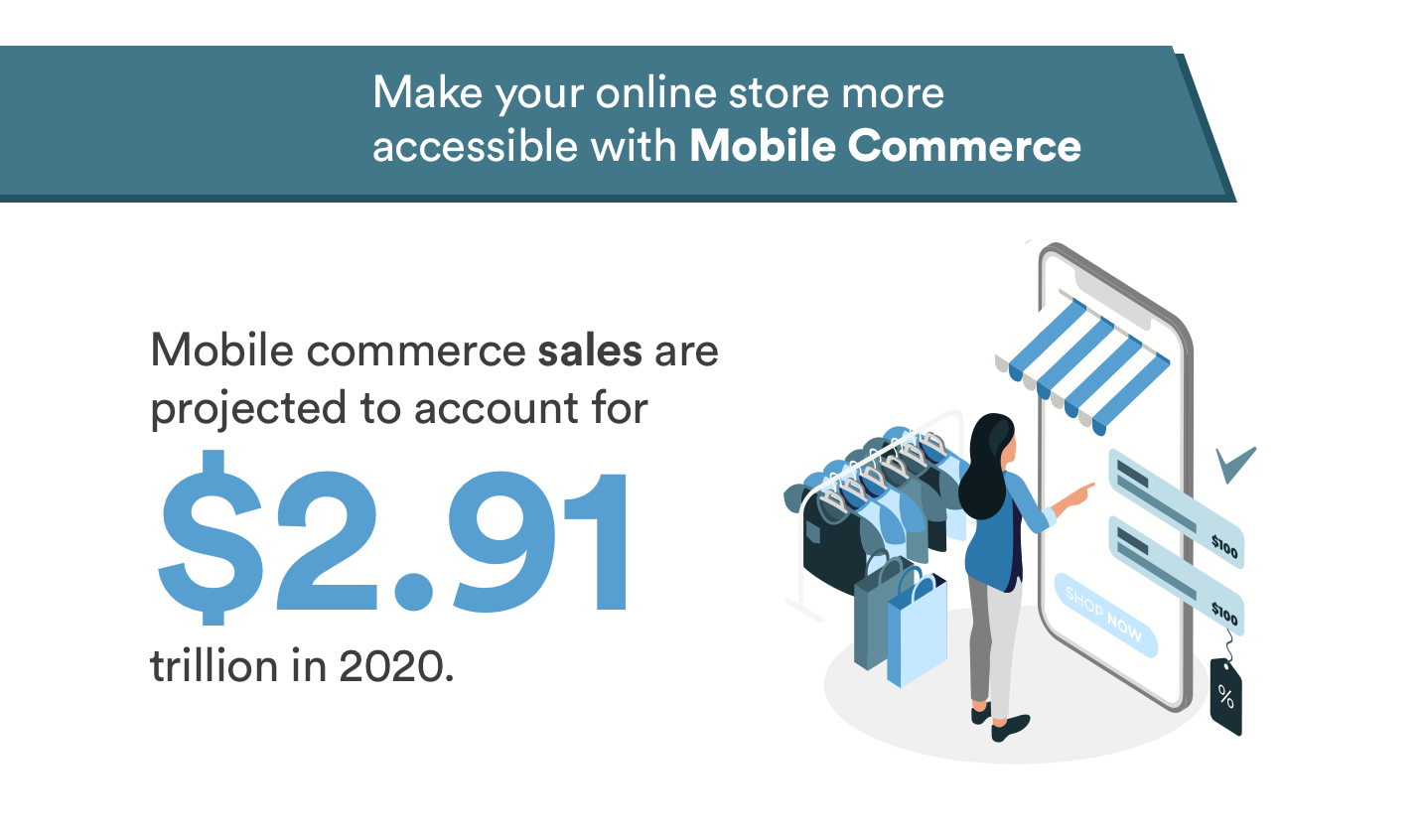
Tap into a bigger user base with mCommerce: Calling mobile commerce an eCommerce trend would be an understatement. It’s a phenomenon taking over online shopping by storm. By 2021, more than half of online sales are going to belong to it. Maybe the year marks the beginning of an instrumental shift. These tiny handheld devices are going to account for approximately $2.91 trillion in sales.
Improve brand recognition with easier accessibility: Mobile commerce would let people go through your store while on the go. They can be anywhere doing anything, yet your store would be a few screen taps away. Even the app logo on their phone screen would keep reminding customers of you.
Capitalize on higher conversion rates of tablets: Mobile devices don’t yield as good conversion rates as you’d want. In fact, stats suggest the larger the screen the better the turnout. The tablets (5.5%) also beat mobile devices (3.2%) when it comes to conversion rates.
Cater an omnichannel experience and boost sales: Other than the small screen size being the kryptonite for mobile commerce, nothing seems to be stopping it from being the future of online shopping. Smartphones are a vital interface when it comes to delivering an omnichannel shopping experience. They make for easier payments, smooth GPS tracking, simpler comparison with physical products, faster purchases, and so much more.
Headless eCommerce makes the system more nimble and agile
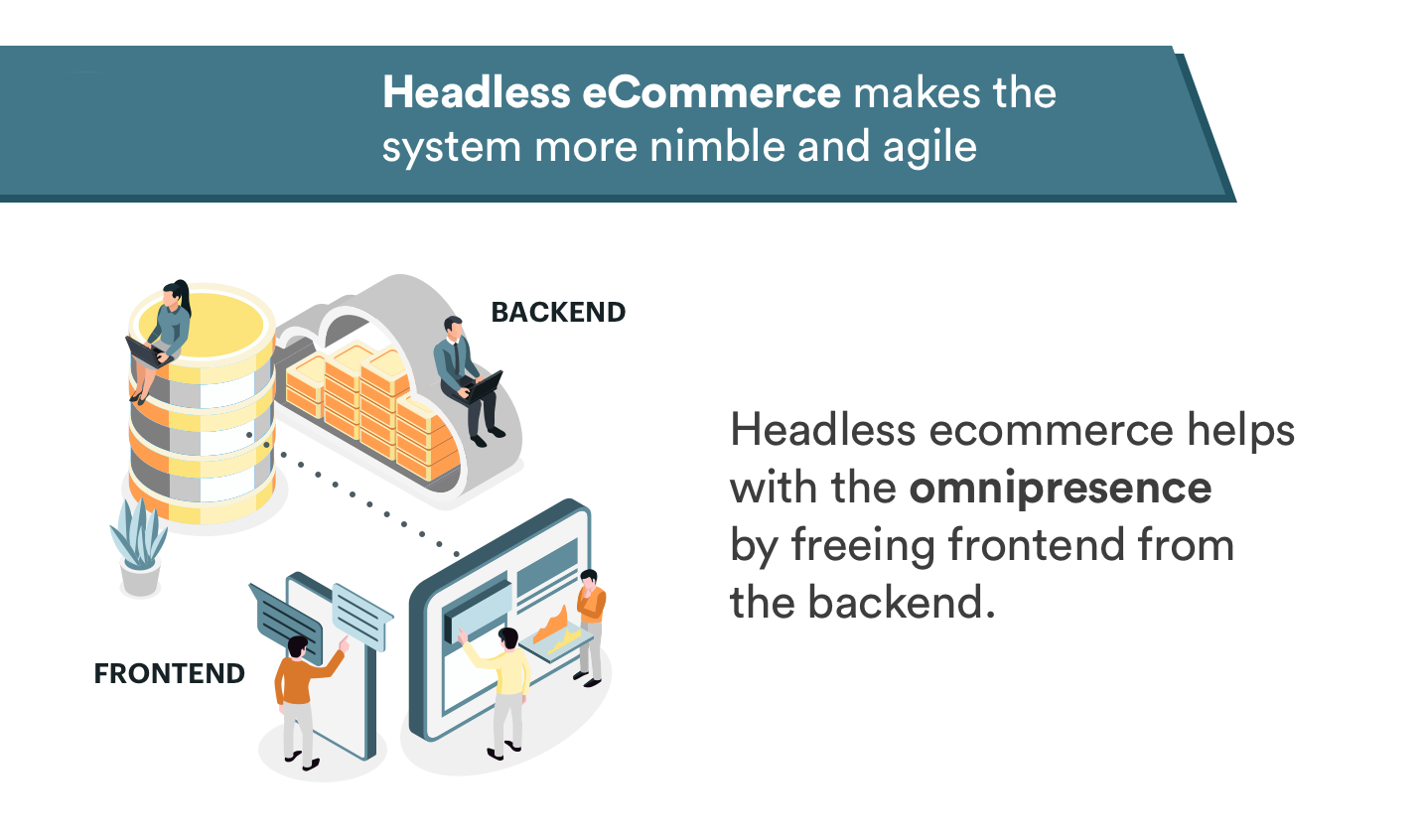
With the abundance of options in the marketplace, it is getting increasingly difficult to impress shoppers. The continuously shrinking attention spans don’t help the case either. This scenario demands eCommerce businesses to stay flexible and keep things fresh.
Get agile by making the frontend independent of the backend: It’s not that easy for large-scale businesses with huge databases to keep modifying things. With conventional architecture, it used to take a lot of work, and yet there used to be the apprehension of so many things going wrong at once.
These circumstances gave birth to a new eCommerce technology trend called headless eCommerce. It is an eCommerce architecture in which the frontend and backend aren’t so heavily dependent on each other, thus making the entire system a lot more agile.
Get more brand recognition with an omnipresence: The omnichannel shopping experience isn’t just a buzzword. It is something that businesses need to adhere to, and headless eCommerce helps you establish omnipresence.
The frontend and backend are connected through APIs, which means there are endless possibilities to deploy the frontend. It no longer needs to have the same blueprint as the backend. Marketers can have appropriate frontends for websites, applications, kiosks, refrigerators (yeah, it’s a thing now), and so much more.
Become nimble and gather more profit: The independence of the frontend from the backend also means that you need to wait a lot to update interfaces or roll out changes. The nimble nature of eCommerce would allow you to stay on top of market trends. And the earlier you adapt to market needs, the more profit you get to make.
You can’t see it just as a future eCommerce trend but start thinking of ways to base your eCommerce infrastructure around it.
eCommerce platforms and frameworks for varying needs

We are both blessed and cursed that there are so many ways to go about eCommerce web development. From platforms that don’t require the developer to write a single line of code to eCommerce platform development from scratch, the options are plenty.
There are variables associated with every business that govern the optimum strategies and processes. It doesn’t make sense for a small eCommerce business to develop a custom-built platform. And if you are expecting to scale massively in the future, it’s better you avoid heavy dependence on a single platform.
Here is a brief of the technologies and platforms trending at the moment when it comes to eCommerce development.
Platforms
WooCommerce (26%), Shopify (20%), and Magento (9%) are titans of the eCommerce world. Together they make up for a huge chunk of active eCommerce websites. The fundamental differences between these platforms are a great indicator of what eCommerce businesses want these days.
One common thread binding all these platforms is that you might need some outside help as the business scales up and gets complicated. Yes, even in the case of Shopify.
we can help you get the right eCommerce developers and specialists. It takes care of all your needs right from extending your existing eCommerce development team to hiring eCommerce developers to create an online store from scratch.
Frontend
No one likes a sluggish interface or a poorly designed UI/UX. The frontend has become more crucial than ever, and the same applies to any eCommerce website. It needs to be aesthetically pleasing and responsive to grab a visitor’s interest.
There are plenty of fish in the sea when it comes to frontend technologies. You have relatively primitive options such as HTML and JavaScript, and then there are technologies like AngularJS and NodeJS for more efficiency and complexity.
Backend
Reliable logic is the immediate concern when the eCommerce backend comes into picture. There is again a myriad of backend technologies ranging from PHP to Python that you can use in the backend.
Usually, we see NodeJS or Spring at the backend of eCommerce websites. However, if you are expecting to get a lot of traffic on the site, then Magento might be your best bet. It is based on PHP but takes excellent care of the logic. The robust infrastructure won’t even flicker when traffic volume goes up and you’d be able to negate downtimes with ease.
Experience and expertise are the two things you are going to need irrespective of the way you choose for development. we comes with both these attributes and can help with all your eCommerce development needs.
Better UI/UX leads to more customer retention

Retain more customers with better UI/UX: First impressions are lasting, and 94% of them are design related. It’s funny how the technologies and platforms we discussed in the previous section don’t even come into the picture if the website is poorly designed.
It should not take a burning trend for you to realize that success has a customer-centric approach at its heart. Companies like Airbnb, Mint, Google, Uber, Apple, etc. owe a lot of their prosperity to user-centric designs and strategies.
UI/UX has one of the best ROIs: Amazon invested 100 times more on customer experience compared to advertising. They made sure visitors don’t get lost in the jungle of product catalogs and quickly find what they need. The personalized suggestions sweeten the deal even further.
Better designs lead to improved conversion rates: Making visitors stay longer on the website and having them keep returning to the site is an ability everyone wants to possess these days. The continuously shrinking attention spans make it an even more valuable virtue.
Research by Forrester suggests a frictionless UX design can increase conversion rates by 400%. Stats like these are going to motivate businesses to invest more in a customer-oriented UI/UX.
If you haven’t been focusing on better UI/UX already, this is the perfect time to invest in a human-centered design.
Social commerce is critical to an omnichannel experience

Get more traffic by harnessing social media: There are 3.5 billion social media users in the world, and social commerce lets you tap into this massive pool of potential customers. No matter how good an eCommerce website you create, it would hardly ever beat the traffic volume social media websites enjoy. You can try redirecting some of this juice to your website or sell the product on the social platforms.
In any case, leveraging social media platforms should be a significant part of your eCommerce strategy. 87% of the shoppers say social media sites help them with the buying decision. Now we can only wonder what can be achieved with a positive social media image.
Social commerce is popular because it provides seamless, frictionless sales experience. Users prefer social environment over external websites when searching for or purchasing something. Creating an easy social eCommerce experience will encourage users to finish their purchase. pic.twitter.com/aQf0smTGNY — Sourcify (@sourcifyinc) March 12, 2020
Utilize positive reviews to get more sales: A positive review on these sites can help elevate the product price by 9.5%, whereas conversion rates go up by 133% for mobile shoppers reading reviews on social websites. People are often intrigued upon discovering new products on social sites. So much so that 55% of consumers have made a purchase in this manner.
Expand your store to social channels: Another reason for social commerce to be an eCommerce trend is its ability to improve the omnichannel shopping experience. Consumers can now buy products directly from social websites and that too with a few clicks. In fact, 30% of consumers say they would prefer buying products this way.
It only makes sense that you take advantage of existing online hubs such as Facebook and Instagram. A more prominent role of social media in future eCommerce marketing strategies is inevitable. And you should capitalize on it right now to dodge the catch-up game later.
The wrap up
The eCommerce industry has been evolving ever since its inception and shows all signs of continuing to do the same in future. The trends mentioned in this article won’t help you stay on top for eternity. You can very well be sure of new technologies showing up, becoming trends, and taking over eventually.
However, these will set you up for the near future- the end of the current evolution stage. You can include them in your ongoing practices and strategies to see improved results. It might be more sales, higher traffic, improved customer satisfaction, more sophisticated infrastructure systems, and so on. These trends might as well be the stepping stone for what comes later, so you don’t want to skip them.
What eCommerce technology trends you think are going to play a significant role in the future? Share your take in the comment section.
Need help implementing these eCommerce technologies? We provide eCommerce development services that will help improve the digital shopping experience on your platform.
